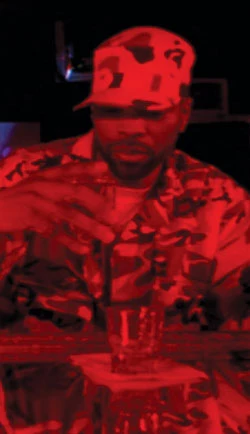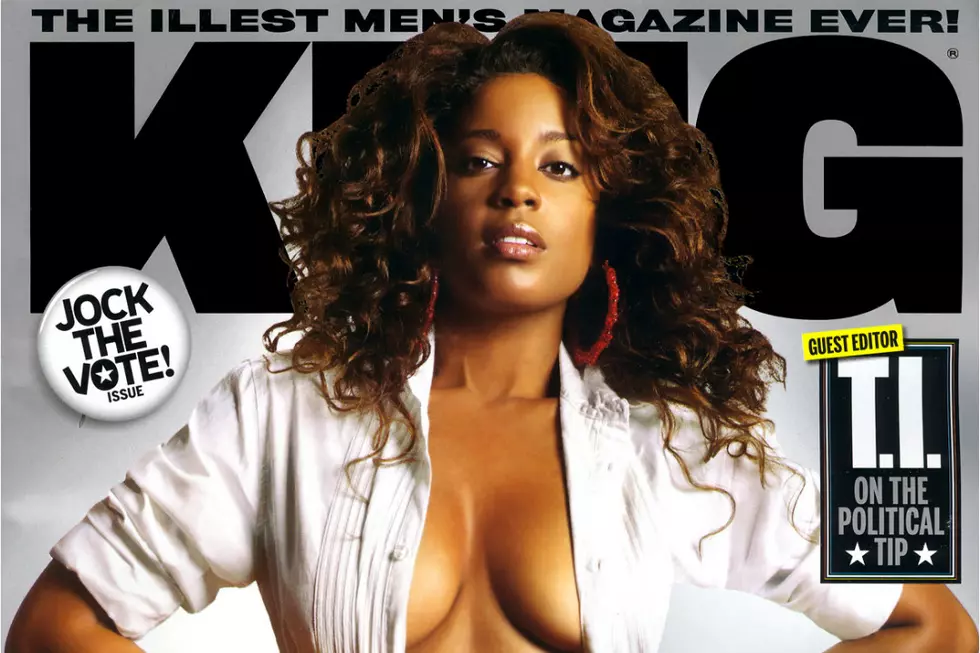Belly Oral History
 After a long search, Hype Williams*, the director of the film Belly, still hadn't found his Bundy. Wu-Tang Clan executive Oli "Power†Grant was considered for the part of the hotheaded trigger-happy gangster, as was Hassan Johnson, a future member of The Wire cast. Irv Gotti then made a recommendation. "I thought [DMX] would be perfect for the role,†Gotti says. So on a rainy night he went to Williams' hotel room and made his sales pitch. "I begged him to let X do it. Word to mother, I begged him.â€
After a long search, Hype Williams*, the director of the film Belly, still hadn't found his Bundy. Wu-Tang Clan executive Oli "Power†Grant was considered for the part of the hotheaded trigger-happy gangster, as was Hassan Johnson, a future member of The Wire cast. Irv Gotti then made a recommendation. "I thought [DMX] would be perfect for the role,†Gotti says. So on a rainy night he went to Williams' hotel room and made his sales pitch. "I begged him to let X do it. Word to mother, I begged him.â€
At the time, Earl "DMX†Simmons was a former stick-up kid and the hardest working rapper in New York. His sinister aura and unrestrained passion on "24 Hours to Live,†"Money, Power, Respect†and "4,3,2,1†proved he could stand out among stars like Mase, LL Cool J and Method Man. But act? In a movie? Even Dark Man wasn't so sure. "He was a little nervous,†remembers X's wife, Tashera Simmons. But the character wasn't a stretch ("It was pretty much me,†X says) so he nailed the audition and became Tommy "Bunz†Bundy. It was perfect casting. At least something went right.
Belly, which was released in theaters on November 4, 1998, had its problems. It was over budget, on-set clashes between the director and the producers were routine, the script—which wasn't so strong to begin with—was being cut and fiddled with during filming, and some of the actors were often drunk, high or late. Sometimes all three. Basically, it was an exercise in how not to make a movie. Critics hated Belly—Variety dubbed it a "cinematic menaceâ€â€”but the people didn't. Though it only made $3.45 million on opening weekend, Belly had the second-highest per-screen average in the top 10. It would eventually gross $9.63 million and become a cult classic on DVD. Now, 10 years later, KING investigates the making of a movie that is still remembered, still quoted and (for some reason) still loved.
* Hype Williams declined to be interviewed for this oral history.
 ANTHONY BODDEN (COWRITER): I got into a car accident in 1992. Hype, who I knew since kindergarten, came to my hospital room and told me, ‘Once you get out of here, we're going to start making movies.' I started writing the movie in 1993. [Years later] Hype calls me out of the blue and says he has a possible investor and needed me to pitch the story. I'm the pitch master, so I flew with him to L.A., and we met Bill Block at Artisan. I told him the whole [story]. Dude got his pen out and was ready to sign right there.
ANTHONY BODDEN (COWRITER): I got into a car accident in 1992. Hype, who I knew since kindergarten, came to my hospital room and told me, ‘Once you get out of here, we're going to start making movies.' I started writing the movie in 1993. [Years later] Hype calls me out of the blue and says he has a possible investor and needed me to pitch the story. I'm the pitch master, so I flew with him to L.A., and we met Bill Block at Artisan. I told him the whole [story]. Dude got his pen out and was ready to sign right there.
MALIK HASSAN SAYEED (DIRECTOR OF PHOTOGRAPHY): Artisan was a DVD distributor, and this was their first production. Then it was Shooting Gallery who had grand schemes [for Belly]. Artisan wanted to make a good film. At the same time, Shooting Gallery had other agendas.
LARRY MEISTRICH (PRODUCER): My company at the time, Shooting Gallery, had a pretty big presence in New York and Artisan didn't, so they wanted us to help them manage the process. We also had some experience with other hip-hop-related [projects] like New Jersey Drive. So they thought we could help with the process.
SAYEED: Hype, myself and Little X went to Jamaica and basically completely broke down the script, scene by scene, shot by shot, and X storyboarded the whole movie. We had a very specific visual direction. We obviously started with character and story; then we talked about how to approach everything visually.
DMX (ACTOR, "TOMMY ‘BUNS' BUNDYâ€): Hype definitely had a vision. He had us oiled down. Every day, baby oil. Yeah, yeah. He wanted this shiny look.
JUNE AMBROSE (COSTUME DESIGNER): Hype was like, "I want Belly to forecast what the hip-hop genre's gonna look like in the millennium. I want you to use this as a platform to do that.†And I think there were areas in which we did. I went to London and brought Evisus into the States. I used the Ecko rhino for the first time.
JAMES BIGWOOD (PRODUCER): Hype had high hopes for bigger names to become involved, and sometimes he held on to those hopes longer than I would have hoped, given the realities of having to get the film shot. There were scenes that he held back from shooting because he was hoping to get [someone] to play the part who ultimately didn't. It ended up hurting our schedule because he didn't have anybody to play the part.
SAYEED: Frank Vincent came in as an acting coach. He wasn't brought in to play that part, but I think one day it struck Hype. I can't remember who else he wanted.
FRANK VINCENT (ACTOR, "FEDERAL AGENT ROGERâ€): They wanted me to shave my head, but I wouldn't do that. It would take me out of business for a while. Hype wanted me to look different, so they tried to put a skullcap on me. I have pretty thick hair, so they were gluing it down. When they shot it, the skullcap kept coming up in the shot. They couldn't get it to stay down, so I decided rather than lose the scene, they shoot it with me blurry.
WINSOME SINCLAIR (CASTING DIRECTOR): The Elijah Muhammad–like character was the most difficult to cast.
DR. BEN CHAVIS (ACTOR, "REV. SAVIOURâ€): I don't think there was talk of the Minister [Louis Farrakhan] playing that role.
SINCLAIR: I think there were some brief discussions, but for some reason, the Nation decided it wasn't something they wanted him to do.
BIGWOOD: I know Roger Smith was scheduled to play it and was actually on set one day, but ultimately Hype decided that he wanted to go a different way.
BODDEN: Hype wanted Gwen Stefani [for a role]. I think she read the script and was almost OK with it, [but then] she got cold feet, or something happened with management. We pulled her character out of the script. Bottom line, she was going to end up beheaded.
SHYHEIM (RAPPER): I was cast for a part, and one day during rehearsals, the car ain't show up. I call the production and they go, ‘Oh, you didn't get a call? You're not in it.' Another rapper felt real insecure on the set. It was the star, [Nas]—supposedly. Foxy Brown, man. They had the Firm at the time, and I was friends with Foxy. You know it was political.
HASSAN JOHNSON (ACTOR, "MARKâ€): The first day of shooting was crazy, 'cause it was a straight video. We was in [New York City's legendary nightclub] the Tunnel.
CHRISTIAN EPPS (GAFFER): We could have done the first two days at $7 million. I'm exaggerating. [Staying under the budget] was clearly going to be a challenge.
RJ HARPER (PRODUCER LIAISON): That scene ran over. I think we shot for two days, minimum. Hype wanting to light everything with this really over-the-top, typical Hype Williams music-video look was his biggest mistake and the biggest problem he had with the Shooting Gallery.
MEISTRICH: You know, [Hype] was a first-time filmmaker. There's always an extra degree of work that goes into that. Film is very different, production-wise, from music videos. So I think that was an adjustment for him. Music videos happen very quickly, and you shoot a lot in a day, and they're often nonunion. In film, it happens slower and very unionized, and there are rules with that, and you kind of have to follow them.
BODDEN: We were trying to do everything nonunion for budget reasons and for rebelliousness. We were just silly, because now that I look at it, that's not going to happen.
EPPS: On paper, Belly was budgeted at [reportedly] $7 million. Thirty-day union shoot in New York: You can do the math, and it becomes painfully obvious that that's impossible for a director with Hype's talent and eye. I think it was genuinely known in the production office before the first shoot date that the budget and the creative taste didn't line up. How did the studio settle it? They never did.
 JAMES PARRIS (ACTOR, "LaKIDâ€): Hype was arguing with the producers every day, because he felt like they were trying to strip him of the creative control. So he would argue on-set, like, "Look, I'll walk off this set, and everybody's gon' walk off with me.â€
JAMES PARRIS (ACTOR, "LaKIDâ€): Hype was arguing with the producers every day, because he felt like they were trying to strip him of the creative control. So he would argue on-set, like, "Look, I'll walk off this set, and everybody's gon' walk off with me.â€
MEISTRICH: There's clashes on every set, so…yeah, I'm not comfortable going into sort of the specifics, the day-to-day production stuff. I don't know why it's pertinent.
BIGWOOD: There were some days where we just didn't make the day, and we couldn't come back to the location, so it happened. There was one day where we were at the Jamaican drug lord's mansion, and I was told that we had to shut down the generator and stop the day. I knew Hype wasn't finished with what he had to shoot, and I knew he wasn't happy that I did that. I think he actually squeezed off a shot while everything was being put away that he got into the movie.
METHOD MAN (ACTOR, "SHAMEEKâ€): Hype had to work with what he had. They were pulling on his pocket every five minutes, like, "Over budget…don't have no licenses for that…we can't do that.†But Hype done did that pirate shit on the street with videos, and they not in the video world, so they don't know Hype could just go and shoot some shit and make it work.
RODRIGO GUERRERO (ART DEPARTMENT INTERN): It was funny because everyone was saying, "Rodrigo, this is not how films get made. Do not learn anything from Belly.†It was chaos.
-----------------------------------------------------------------------------------
More From King







